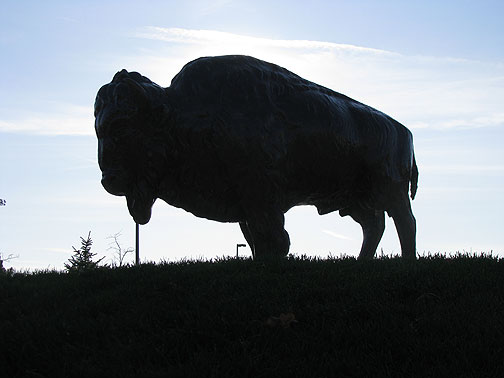
Buffalo, an animal and a city...
Spent two and a half days in Buffalo, a place I’d never been before”¦ Always wondered why it was named Buffalo since that beast probably never roamed anywhere near here. Locals say it’s derived from a French expression Beau L’eau, with an “˜f’ somehow inserted into it by long lost accents”¦ the beautiful water of course would refer to the Niagara River meeting Lake Erie here, along with a variety of smaller waterways. Pouring through the Niagara Gorge, a famously beautiful natural rock formation, the waters then plunge over Niagara Falls a short way north of here.
I heard a lot about the local water from a woman I met last night, Katie B., who hails from Athens, Georgia. She works locally with a Riverwatcher nonprofit, helping local citizens monitor water quality in wetlands, creeks, and rivers hereabouts. She loves her job which she was anxious to tell me after my public appearance on a panel last night, where I gave my usual rant against useless, stupid work. It was at a place called “Sugar City,” mostly known as a punk rock venue. (Oddly it seemed like a sweet local art gallery much more than a punk venue, but I think that’s because they had to shut down for 3 months due to hostile neighbors, and are now reinventing themselves as a good neighbor.) It’s a great spot in one of Buffalo’s thriving districts, Allentown, full of historic architecture, a hopping bar scene at night, and a fine used bookshop, Rust Belt Books. The bookstore owner, Christie, told me in a brief conversation about the city, “Buffalo is not depressed. Buffalo is unimpressed!”
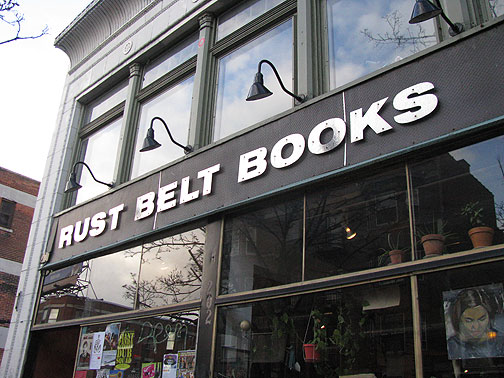
Rust Belt Books in Allentown district of Buffalo, NY.
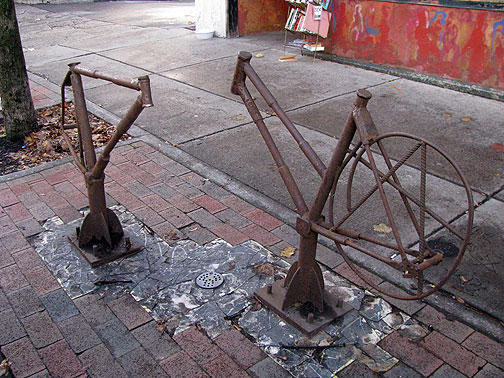
Cool rusting bike racks in front of Rust Belt Books.
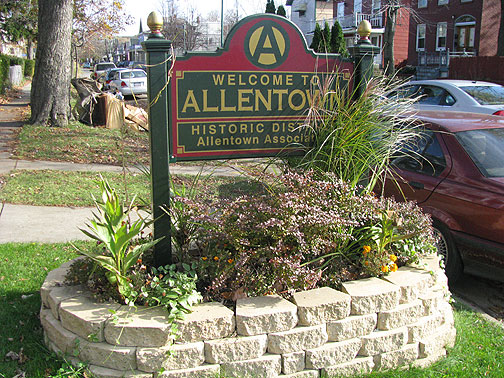
Allentown District sign, with its surprising invitation to anarchists to be residents!
True enough, it’s a town full of secret energies and a palpable sense of an interesting future embedded in a depopulated, often devastated landscape. This is after all the home of Love Canal and countless other lesser known toxic catastrophes (probably some still ahead). Buffalo was one of the most important cities in the U.S. back in the 19th century, first when the Erie Canal arrived in the early part of that century, and then during the long booms and busts of industrialization that followed. At its earliest moments around 1820 there was even a communal society that built a thriving village called Harmony on forested land purchased from the Seneca Indians, in an area now absorbed by the city of Buffalo.
My sponsor here, Al Larsen, teaches in the Media Studies Department at SUNY Buffalo. I learned that the north campus where I appeared midday yesterday (and where that Buffalo statue sits) is a symbol of much that has gone terribly wrong in local urban design and planning over the past two generations. There was already a smaller downtown campus, and what is called the South Campus, when Nelson Rockefeller in his stint as governor of NY allocated a great deal of funding to establish the SUNY system (absorbing various local universities, including Buffalo’s). A new campus was planned, and after three different commissions approved its location downtown the decision was made”¦ put it in swamplands far north of the existing South Campus (the landowner was obviously connected to the actual decision-makers). There is in Buffalo a one-line subway system (apparently the smallest city in the world with an underground subway) that runs from the downtown campus to the South Campus. As part of the planning for the new campus, monies were allocated to extend the subway to the new North Campus. They were never spent and the subway was never extended. The two campuses are far apart, and it was explained to me last night that the bicycle ride to the North Campus is about 10.5 miles on heavily trafficked highways” extremely unpleasant. So thousands of faculty, staff, and students drive to the campus every day, for lack of reasonable alternatives (there is a shuttle between the campuses too).
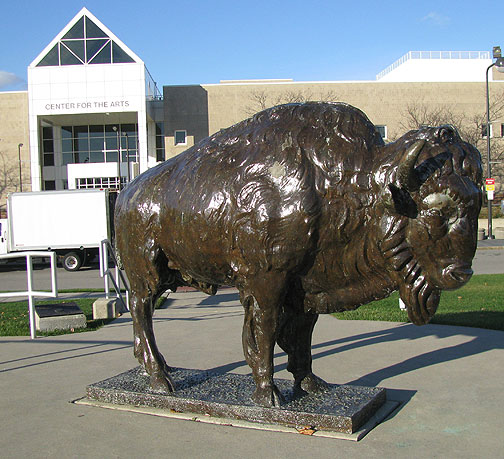
The bronze mascot in front of the North Campus Center for Arts.
Buffalo was an early car city. The streets are super wide, and at this point, given the smaller population (only about 300,000 in the city) there is a huge surplus of street parking in downtown and elsewhere. Thousands of homes are crumbling and abandoned. It’s possible to buy houses in Buffalo for as little as $10,000 each, and easy to find huge, old homes with elegant architecture and a dozen rooms for under $100,000. There is a stark divide in the city between east and west, a divide imposed by the wrecker of New York, Robert Moses, when he was the state director of Energy and Highways. A major freeway was put down the spine of the city, another was wrapped around the waterfront (they could use a good earthquake here to help get rid of it!), and today the east side has vast tracts of abandoned lands where houses once stood.
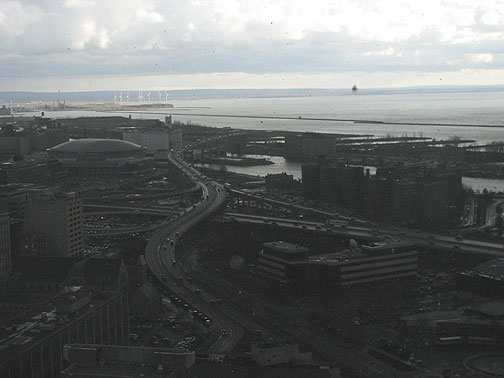
Freeway in need of a quake! In distance are windmills on an otherwise toxic site.
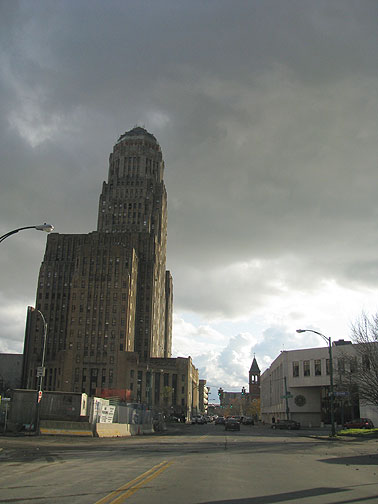
Buffalo's gorgeous art deco City Hall, built in the 1930s.
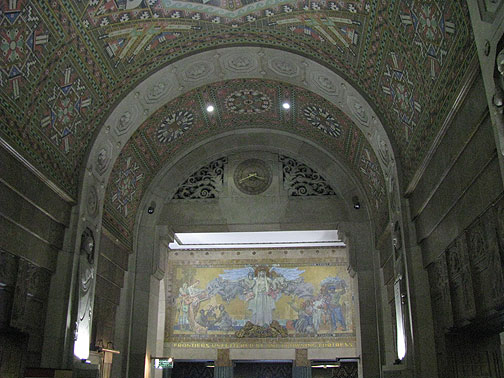
The lobby is full of Indian motif deco and some mosaic murals... through the arc the slogan on the mural says: "Frontiers Unfettered by any Frowning Fortress."
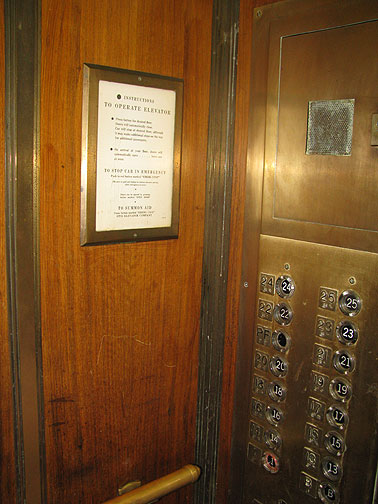
Instructions for elevator use?
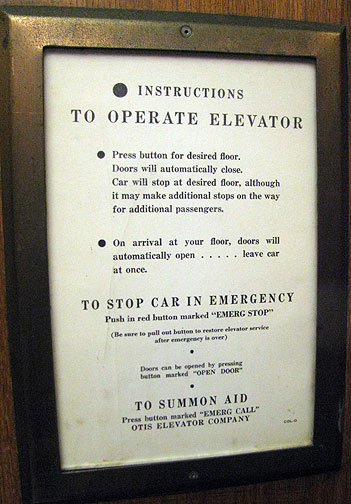
Yes!
The good news is that there are over 80 community gardens and a great deal of energy to expand those efforts. Bicycling has its advocates: there is a small-ish Critical Mass, a larger Sunday midnight ride, and a great deal of promise when it comes to putting local streets on a “road diet” and moving towards a Copenhagen-style system of dedicated bike paths. But, as the eloquent Justin Booth of GreenOptions Buffalo said last night, there is a dearth of political vision or leadership in this city. In fact, by all accounts, it’s a thoroughly corrupt city government doing very little to help or advance the many initiatives underway. According to Booth, Buffalo is one of the few cities to pass an ordinance that requires all street repairs or changes to accommodate bicycles and pedestrians, but it has been mostly ignored in practice. He took a couple of local transit engineers to a conference in New York City recently and they were quite inspired by the many (Danish-inspired) changes underway in the Big Apple. So maybe Buffalo is about to enjoy some meaningful repurposing of its streets towards a more human-scaled life, less car-centric.
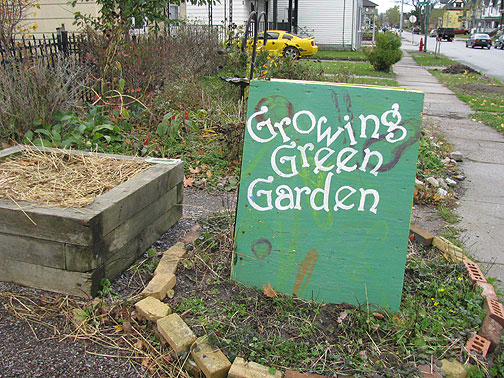
There are over 80 community gardens in Buffalo.
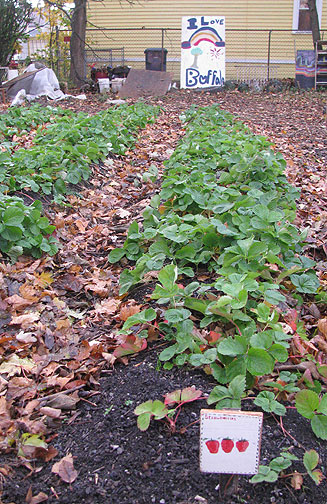
November strawberries in Buffalo!
Not far from the Allentown district where I spent the night last night is an effort called the Massachusetts Avenue Project. The neighborhood around it is quite poor and the housing is not in good shape, plus there are a lot of vacant lots. In one two-lot area the MAP has established a green garden, mostly using raised beds (there’s a lot of concern here about contaminated soils due to the long history of industrial waste).
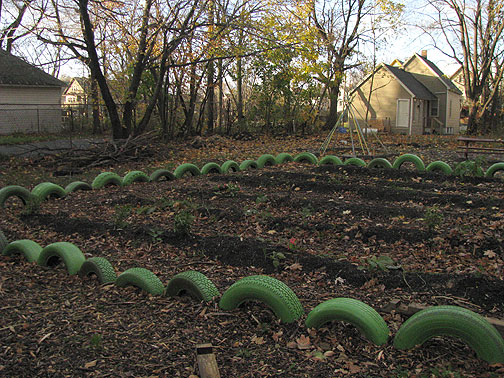
These green tires are growing in a garden near a place called Buffalo Reuse, sort of like SF's Building Resources.
Jesse Meeder, the garden director, has built an incredibly impressive small fish farm, taking his inspiration from Milwaukee’s Growing Power. In this small cob-walled structure the temperature hovers around 80 degrees while water circulates in and out of watercress tanks, the fish tank where small tilapia are growing, and a variety of other buckets full of herbs and plants to help filter the water before it circulates back to the start again. The black tubing absorbs a lot of solar heat and keeps the whole place quite toasty (outside it was 39 degrees!). In a local newspaper article that happened to appear the day I arrived in Buffalo, they insist that calling it a fish farm is to miss the point,
which is to create a miniature ecosystem where the fish, plants such as basil, parsley and watercress, and compost energized by 5,000 red worms feed one another in a manner similar to the way nature operates. The technical term is “aquaponics.” “The system is perfectly balanced,” Meeder said. “We’re trying to replicate the natural environment. That’s what farmers should be doing.””¦ With the major expense being the water pump and the heater, the whole project came in at no more than $500 for materials.
They have a 1000 gallon rain barrel to capture the water they use, and with solar heat, they have developed a system that will deliver a lot of fresh fish protein to the surrounding residents. A good deal of Buffalo was described to me as “food desert,” so these kinds of projects are really exciting for their replicability and low cost. They expect their first crop of tilapia to be ready in early Spring and to be 1 to 1.5 lbs each.
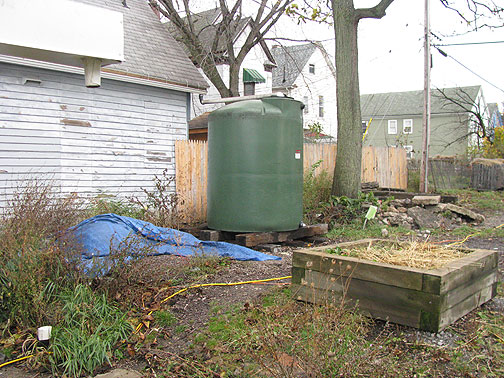
1000 gallon rain catchment barrel at the Massachusetts Avenue Project in Buffalo.
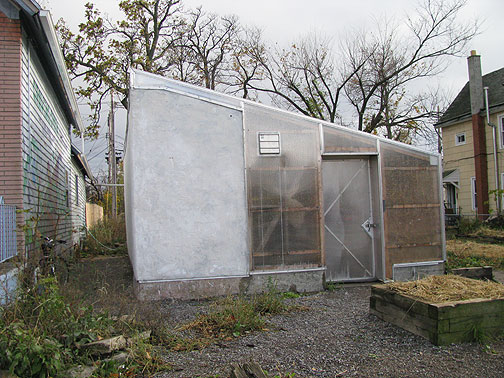
The fish farm is in here, cob-walls and a full facility built for less than $500.
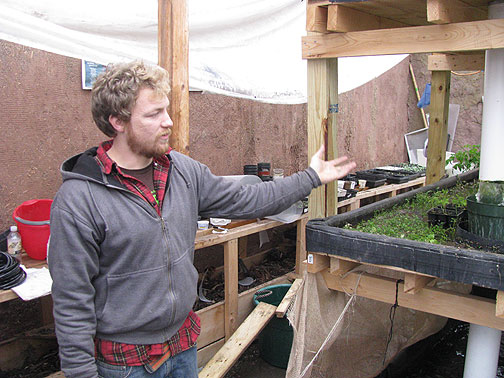
Jesse Meeder explains how the water circulates from one area to another in his fish farm.

The black tubes help circulate warm water from one tank to another.
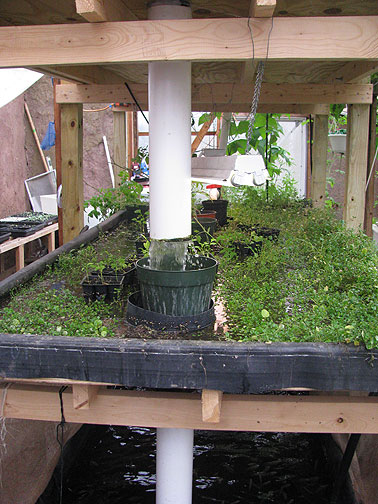
Watercress thrives in upper pool.
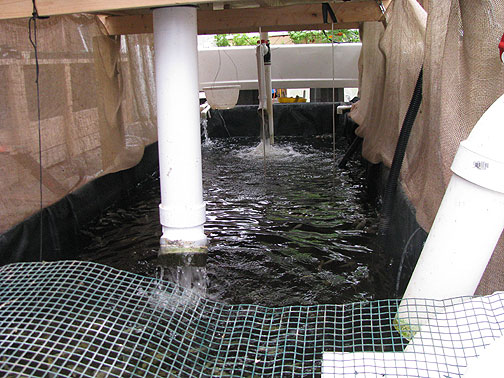
Tilapia thrive in lower pool.
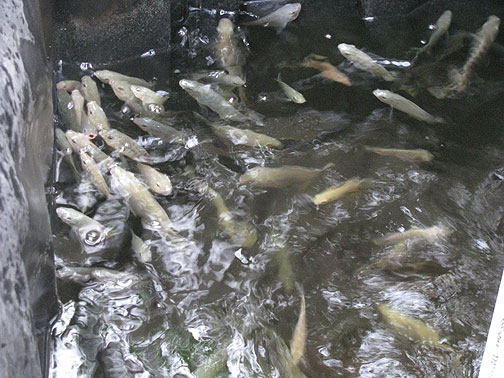
The tilapia will be 1 to 1.5 lbs each when they're ready for sale.
This morning I woke up in the home of Isabelle and Tim. She’s part of a local community improvement nonprofit called “Heart of the City” and they organized a tree-planting today. Over 1000 trees were going to be planted around the city and they had a few dozen going in to the ground as I was leaving. Buffalo has a huge potential. There are countless elegant homes waiting for rehabilitation, fantastic old stone churches everywhere are ripe for conversion to social centers, and the seeds of a new Commons are taking root in small pockets across the city. Thanks to everyone in Buffalo who gave me such a warm welcome and showed that inspirational and prefigurative activities are everywhere!
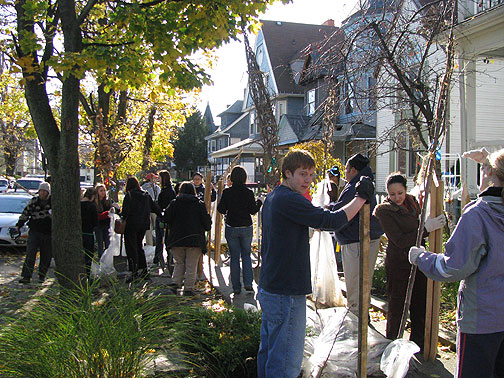
Allentown neighbors heading out to plant trees.
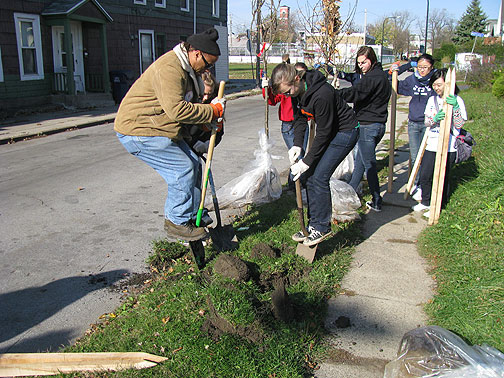
Jump digging in soil that had been near freezing the day before.
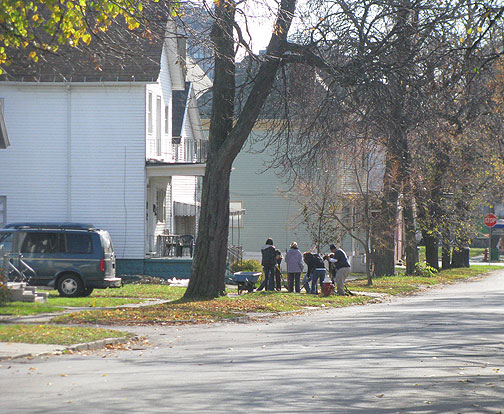
Another group plants trees down the street.
While we were on the observation deck on the 28th floor of City Hall we had a brief flurry of hail and snow… by the next morning it was over 60 degrees. Crazy weather in Buffalo, which is one reason there’s so many available houses there… But anyway, the last photo is your history lesson for the day. Who knew that Irish Civil War vets invaded Canada in 1866? To use a canal as ransom to free Ireland from England? Wow…
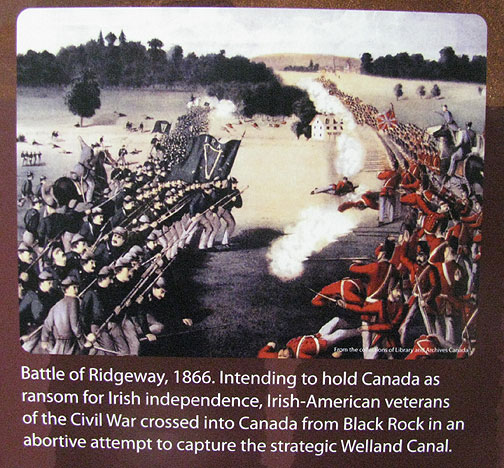
Lost history is everywhere!












Leave a Reply